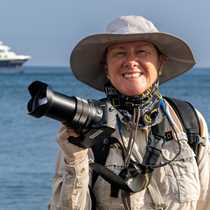Urvina Bay & Pta. Moreno, Southern Isabela Island
No better way than to get people up than with a quiet announcement mentioning dolphins. I’m not sure if anyone in pajamas showed up because I was much too busy jumping up and down with anticipation at our approach to a pod of around 100 bottle-nosed dolphins. Bleary-eyed folks appeared almost immediately with coffee, binoculars and cameras in hand.
Each and every volcano of Isabela and Fernandina Island was clear, not a cloud to be seen. The sea was flat calm, the sun low, only a half-hour away from sunrise. Again and again, the dolphins approached us to take turns (some jostling for position was noticeable) bow-riding the double bow of the National Geographic Islander. Some incredible leaps were made, and one individual seemed determined to jump part-way straight up towards the faces overhanging the bow rail. With the deep blue of the water and not a ripple to disturb our reflection, I’m sure I wasn’t the only one who dreamed of diving in and merging with these characters of the sea. The photograph I include is not a double exposure as some would like to believe, but a true image of what we saw, albeit dizzy with emotion and hanging heads over the bow.
For the rest of the morning we explored the lowlands of Alcedo Volcano, Isabela Island, in search of land iguanas which we found aplenty. Four young Galápagos hawks stalked over the black sand beach between marine turtle nests and between snorkeling bags, searching for something to eat (and not finding anything). The visit ended with a 600 meters “Megaswim” from shore to ship; only because sea conditions were perfectly calm was it possible, with 11 starting out, and 11 finishing well.
The afternoon had us visiting even further south on Isabela Island at Pta. (“punta” or “point”) Moreno, a harsh landscape of young pa-hoe-hoe lava fields with a hidden oasis of lagoons surround by mangroves and grasses where pintails, blue-winged teals and the occasional stilt reside, if only for a day or two. At first the view was hidden by a curtain of solid rain, but after postponing our departure only 15 minutes, the cloud had passed by and the sun started to shine, so out we went.
A young flightless cormorant looked extremely interested in boarding the Zodiac, but settled instead for attempts to pull out the drainage plug. The visit turned out dry for the rest of the afternoon, and the sunset…well! Any sunset watched while at anchor surrounded by the live volcanoes of Isabela and Fernandina…is a fine sunset indeed.
No better way than to get people up than with a quiet announcement mentioning dolphins. I’m not sure if anyone in pajamas showed up because I was much too busy jumping up and down with anticipation at our approach to a pod of around 100 bottle-nosed dolphins. Bleary-eyed folks appeared almost immediately with coffee, binoculars and cameras in hand.
Each and every volcano of Isabela and Fernandina Island was clear, not a cloud to be seen. The sea was flat calm, the sun low, only a half-hour away from sunrise. Again and again, the dolphins approached us to take turns (some jostling for position was noticeable) bow-riding the double bow of the National Geographic Islander. Some incredible leaps were made, and one individual seemed determined to jump part-way straight up towards the faces overhanging the bow rail. With the deep blue of the water and not a ripple to disturb our reflection, I’m sure I wasn’t the only one who dreamed of diving in and merging with these characters of the sea. The photograph I include is not a double exposure as some would like to believe, but a true image of what we saw, albeit dizzy with emotion and hanging heads over the bow.
For the rest of the morning we explored the lowlands of Alcedo Volcano, Isabela Island, in search of land iguanas which we found aplenty. Four young Galápagos hawks stalked over the black sand beach between marine turtle nests and between snorkeling bags, searching for something to eat (and not finding anything). The visit ended with a 600 meters “Megaswim” from shore to ship; only because sea conditions were perfectly calm was it possible, with 11 starting out, and 11 finishing well.
The afternoon had us visiting even further south on Isabela Island at Pta. (“punta” or “point”) Moreno, a harsh landscape of young pa-hoe-hoe lava fields with a hidden oasis of lagoons surround by mangroves and grasses where pintails, blue-winged teals and the occasional stilt reside, if only for a day or two. At first the view was hidden by a curtain of solid rain, but after postponing our departure only 15 minutes, the cloud had passed by and the sun started to shine, so out we went.
A young flightless cormorant looked extremely interested in boarding the Zodiac, but settled instead for attempts to pull out the drainage plug. The visit turned out dry for the rest of the afternoon, and the sunset…well! Any sunset watched while at anchor surrounded by the live volcanoes of Isabela and Fernandina…is a fine sunset indeed.



